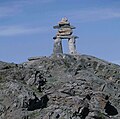Symbols of Nunavut
| Symbol | Image | Adopted | Remarks and references | |
|---|---|---|---|---|
| Coat of arms | Coat of arms of Nunavut |  | April 1, 1999 | Contains symbols of the riches of land, sea and sky. The coat of arms was designed by Andrew Qappik. [2] [3] |
| Motto | Nunavut Sannginivut ᓄᓇᕗᑦ ᓴᙱᓂᕗᑦ Nunavut, our strength | April 1, 1999 | Granted with other elements of the coat of arms [2] | |
| Flag | Flag of Nunavut |  | April 1, 1999 | Featuring colours and an inuksuk referring to the geography of Nunavut, as well as Polaris; The North Star; this flag was designed by the same artist as the territory's coat of arms, Andrew Qappik. [3] [4] |
| Mace | The Mace of Nunavut |  | March 30, 1999 | It is the symbol of the authority of the Legislative Assembly. It is a ceremonial staff carried by the Serjeant-at-arms into the Chamber. [5] |
| Flower | Purple Saxifrage Saxifraga oppositifolia |  | May 1, 2000 | One of the first plants to flower in the Arctic spring [3] [6] |
| Bird | Rock ptarmigan Aqilgiq ᐊᕐᑭᒡᒋᖅ ᐊᑕᔪᓕᒃ Lagopus mutus |  | May 1, 2000 | Lives in Nunavut year round [7] [8] [a] |
| Animal | Canadian Inuit Dog Qimmiq ᕿᒻᒥᖅ Canis familiaris borealis |  | May 1, 2000 | Resident in the Arctic for at least 4000 years [7] [9] [a] |
| Territorial symbol | Inuksuk Inukhuk ᐃᓄᒃᓱᒃ Inukshuk |  | ||
| Licence plate | Nunavut ᓄᓇᕗᑦ | July 2012 | Standard North American rectangular plate [10] |